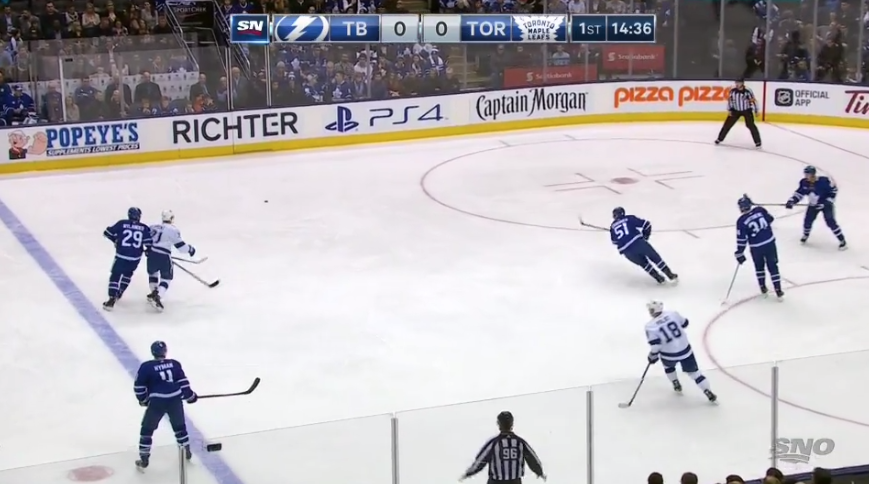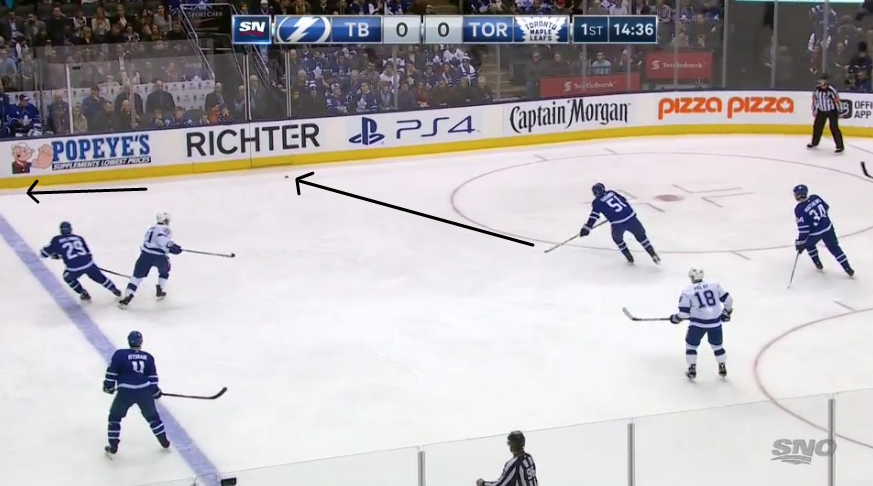Phil Kessel was singled out for doing it. He cheated.
Same thing with William Nylander. He cheats.
Let’s watch Nylander do it right now.
Did you catch it? Every Leaf does it. In fact, it’s mandated.
It begins with the play developing here, with an errant puck off to the right wall following a failed Tampa Bay zone entry. The Leafs have three forwards monitoring the play, with Jake Gardiner making the effort to get to the puck. There’s lots of support and Nylander sees the opportunity to bolt out of the zone, while the Leafs still hadn’t safeguarded the puck in transition.
h

Encapsulated in this next frame: With the puck towards the boards, adequate protection with three players in the high slot, and Gardiner on his way, Nylander does what he’s mandated to do. He cheats out of the zone.
Leaving the zone with speed, he provides a target on the move, with the expectation that Gardiner will get to the stray puck and move it up ice.

Pushing back the defense into the neutral zone creates space high in the defensive zone while in transition.
There are a few more examples taken early from the Leafs vs. Bolts game earlier in the week, all from the first period, but this is a consistent tactic.
I haven’t done the tracking, but if someone has an inclination to do so, I’d guess there would be fewer occurrences in the third period. Even then, there’s likely a dependency on score and position – especially with teams’ penchant to adopt a prevent defense, i.e. collapsing and absorbing pressure instead of maintaining a consistent forecheck and attempting to keep control of the puck. It’s the basic essence of score effects, and even teams that seem to be progressive with new ideas all eventually resort to the “prevent.”
Prevent is death. The Leafs inability to maintain a lead in the third period in 2016-17 had a little to do with this type of play, too. With players transitioning while they should have been providing coverage, the opposition capitalized.
On the topic of less-than-stellar defense, James van Riemsdyk is this concept personified.
The play begins with the Bolts firing a shot on goal, with Andersen making the save but bouncing a rebound right in front. There, once again, Gardiner gains control of the puck. Seizing on the opportunity after the Leafs retained possession, van Riemsdyk explodes out of the zone. Gardiner skates the puck into the corner and starts a controlled breakout instead of hitting the winger outside of the defensive zone. JVR pushes back the defensemen and clears a space for the breakout.
Think this is limited to the skilled players? Let’s check out the Leafs fourth line. Connor Brown is the player to watch in this sequence.
Brown gets low to the net as a winger, protecting the slot and crease front as the Leafs battle for the puck in the corner. With numbers, the Leafs win the puck battle, and the puck squirts behind the net followed closely by Frederik Gauthier.
Once the Leafs gain control with Gauthier circling the goal, Brown has pivoted and is picking up steam to get out of the zone. Gauthier sends the puck up the wing, where the play breaks down at the center red line due to an errant pass. The play is fairly clear and consistent at this point.
Negative connotations are attached to cheating out of the zone generally. It’s easy to spin the technique as a character flaw and leaning heavily toward individualism. A subjective conclusion is made if there’s a bias already firmly in place. Here, the Leafs have incorporated it as a tactical advantage.
And it is an advantage. In a tight league, creating space is important. Using assets while optimizing their skillset and chances for success is important.
Executed properly under controlled situations, forwards push defensemen back into center, opening up lanes and space at the top of the defensive zone to facilitate controlled breakouts for any cluster of players transitioning together.
The Leafs love long stretch passes and also utilize the chip into the neutral zone play, chasing down pucks using their speed and skilled forwards. It’s not foreign to expect the puck to be there now in transition. Is it really cheating if there’s an expectation of the puck being in the area by design?
It’s an example of finding methods that may offer tactical advantages by a variety of different means. It may go against the contemporary theory, but it is progressive and encouraged.
With the current game theory of controlled zone entries, the Leafs still love using plays to chip and chase pucks, placed strategically in an area that they can retrieve it.
This regroup is used sometimes, tipping the scales to a winnable puck retrieval.
By stretching out the forwards and adding mid-lane drive, they back up the forecheckers and force the defending line to pivot to initiate the puck retrieval procedure. Meanwhile, the Leafs forwards, with speed, rig the race and have everyone looking at the puck in the corner behind the net instead of in front.
With time to begin the attack after the regroup, there are two forwards that don’t make it back into the camera frame. Nazem Kadri comes back to the blueline but takes off to receive a pass at the red line before flipping into the zone, where Toronto has a streaking winger engaging the puck retrieval.
I don’t mind pushing the boundaries here. Cheating, in this form, is quite alright with me.















![John Gruden after the Leafs prospects’ 4-1 win over Montreal: “[Vyacheslav Peksa] looked really comfortable in the net… We wouldn’t have won without him” John Gruden, head coach of the Toronto Marlies](https://mapleleafshotstove.com/wp-content/uploads/2025/09/gruden-post-game-sep-14-218x150.jpg)


















